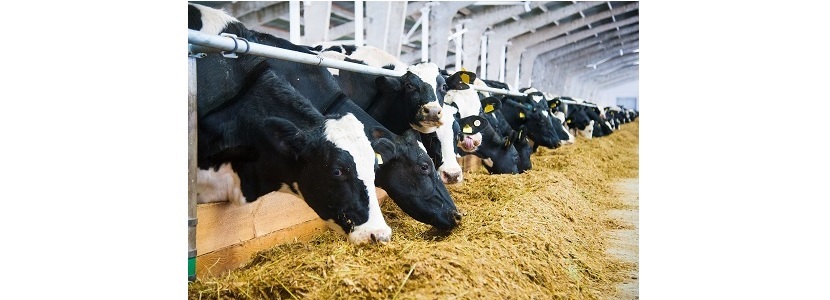Feeding behavior in dairy cows seems to harbor great importance when it comes to improving production parameters. Improving feed efficiency in dairy cattle is important not only for optimizing production costs, but also due to a growing need to reduce waste associated with animal production (e.g. manure and methane) and its impact on the environment.
| Feeding behavior has a two-way association with animal welfare. Some problems related to animal welfare, such as health deterioration or pain, cause changes in eating behavior. On the other hand, changes in eating behavior can lead to health problems. (Figure 1) |
Figure 1. Summary of the two-way relationship between feeding behaviour and animal welfare in dairy cattle, including drivers of feeding behaviour and impact on productivity
Modified from Llonch et al., 2018
Drivers of livestock feeding behavior
Feeding is a predominant behavior in ruminants with animals spending a great part of the day eating. A high-production Holstein cow can eat more than 25 kg of dry matter in a day.
Palatability has a great influence on ruminants’ feeding behavior, due to the fact that the sense of taste is highly developed in cattle (Albrigth, 1993). [register]
Feeding stimulation mainly results in higher dry matter intake (DMI) and increased milk production.
For example, Migliorati et al. (2005) observed that dairy cows which received a flavoured diet (aromatic sweetener)within the automatic milking system exhibited greater interest towards the feeder (increased number of visits) compared to those cows fed a control diet.
Merril et al. (2013) evaluated a flavor enhancer to improve forage palatability in lactating dairy cows and observed a rising trend in DMI (+1.5 kg/d) and milk production (+3.9 kg/d) in multiparous dairy cows.
Social behavior is considered an external factor that also regulates eating behavior
Social facilitation influences feeding motivation, in which the animal is stimulated by the sight and sound of other animals eating (Ginane et al., 2015).
- Therefore, the design and management of the feeder must consider the herd’s social behavior during feeding.
The link between feed management and social behaviour depends on whether cows have free (i.e. unrivalled) access to feed, which affects the total time spent eating and the feeding pattern of each day.
Monitoring feeding behavior
Eating behavior is analyzed through the quantification of the amount and distribution of food intake. In 1999, Nielsen (1999) proposed a method for analyzing eating behavior which can be applied to different species. It considers six different aspects or measurements:
- Dry matter consumption (DMI; kg/day)
- Average consumption per visit to the feeder (kg/visit)
- Number of visits to the feeder (visits/day)
- Time spent in the feeder (min/day)
- Average time per visit (min/visit)
- Feed rate (FR, g/min)
Instead, grass DMI can be calculated based on grazing time, bite rate, and bite size, using the following equation:
Grass consumption = grazing time × bite rate × bite size
In dairy cows for example, the time spent eating daily increases progressively at the beginning of lactation for about 9 weeks. This shows a relationship between feeding behavior and feed consumption.
In recent years, numerous tools have been developed to monitor cows’ behavior, such as pedometers or electronic collars, which measure activity or feeding behavior, respectively.
Another factor to consider about eating behavior is food selection. Dairy cattle selectively consume the shortest concentrated particles in their TMR, while selectively rejecting longer forage particles (Greter and DeVries, 2011). Selection behavior is usually evaluated by comparative analysis and weight between the offered diet and the leftovers.
Feed selection, particularly in TMRs (total mixed rations) must be avoided. Due to the fact that unbalanced nutrient intake and altered rumen fermentation as a result of sorting can adversely affect digestion efficiency and production (Miller-Cushon and DeVries, 2017).
Impact of eating behavior on productivity
The feeding behavior of livestock has a significant impact on productivity and this is due to several reasons.
It has also been suggested that a reduction in feeding rate (gr/min) also mitigates the risk of metabolic problems such as subacute rumen acidosis (SARA) and abomasum displacement (Shaver, 1997).
- On the other hand, faster and more intense meals trigger acid production within the rumen, increasing the risk of acidosis (Allen, 1997).
- Sorting behavior has also been identified as a factor that affects productivity.
Feed efficiency
More efficient animals use less feed for their maintenance, which increases the energy that they allocate to production (e.g. growth or milk production).
In growing dairy heifers, Green et al. (2013) showed that feed efficiency, as measured by residual feed consumption (RFI), correlated moderately to highly with DMI (r = 0.54–0.74). Indicating that at the same level of production (i.e. growth), efficient livestock ate less than livestock considered as inefficient.
- In fact, some studies suggest that more efficient animals may spend more time resting, which results in less energy expenditure. (Golden et al., 2008).
- This effect is especially significant when the diet contains a high percentage of fiber. This is because fiber digestibility is greatly influenced by its passage rate through the rumen, which determines the accessibility of fibrolytic microbiota to the ruminal content.
These results suggest that feed efficiency can be improved by stimulating shorter yet more frequent meals with less (or lower) FR.
[/register]
